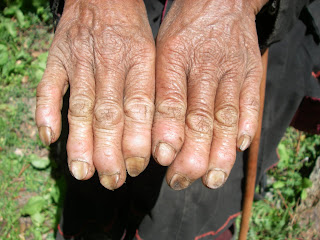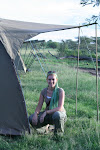I traveled from Delhi to Mumbai via a 17 hour, overnight train... not an entirely unique experience, but certainly an Indian one. We passed the most luscious green feilds and yellow plantations with billowing stalks of wheat and corn... we also passed villages that could have passed for refugee camps, carpeted with blue tarps and muddy roadways. I chatted with a man sitting across from me, and between drinking coffee and eating rice with daal, we managed to have some rather interesting conversations. Amongst other things, I learned that a university-educated mechanical engineer whose daughter is a physician can believe that traditional Indian medicine can cure AIDS and cancer... As always, I am subtley reminded that India is indeed an incredible juxtaposition.
Mumbai is quite a city... the shore, shops, and brightly lit skyline are unexpected, quite welcome reminders of home. Neelam met me at the train station; soft spoken, with calm brown eyes and gentle features, she has quickly become my surrogate aunt. She has been my contact for Impact India Foundation, the NGO that I will be working with for the next few months in Maharasthra. The organization works to strengthen government health programs as well as add their own innovative projects; they work primarily in the villages, and I will be working n Thane Province, in Palghar. I will have several projects, amongst them teaching first aid and emergency medicine principles to specially selected 'health monitors' in the schools, which i'm particularly excited about. In these regions, the vast majority of the population is completely uneducated and ignorant to even the most basic health practices; simple topics, such as rehydration and burn care, can be lifesaving. At the same time, I will be working on developing a manual for IIF's diagnostic mobile, and contributing to their plans for the health fair coming up in October. We leave for the village early tomorrow morning, so i've been using the weekend to relax, read books, and shower as often as possible. On a side note, if anyone's looking for a great book, I just finished "A Thousand Splendid Suns"... quite remarkable.
* * * * * * * * * * * * *
Healthcare in the Himalayas
Examining patients has an entirely different meaning if you're under a tree, in the mountains, and your patient doesn't understand why you need them to take their shirt off - both because they don't speak your language, and because an evil spirit has caused their pneumonia, not a bacteria. I give a great deal of credit to the translators who worked so diligently by our sides; their translations spanned not only languages, but also cultures and generations. In general, our setup was simple: in groups of 4-5 medical students, we worked with a physician to examine and diagnose patients; once everything was written down on a sheet of paper, the patient would carry their prescription to the 'pharmacy' - a table with scattered bottles and notebooks - and receive their medication.
Most commonly, the diagnoses were simple - patients had chronic osteoarthritis, exacerbated by long hours of manual labor; gastroesophageal reflux, exacerbated by spicy foods, or pterygium and watery eyes, due to working in the sun without sunglasses. Colds, warts, scabies, and headaches were endemic; ear infections and pneumonias, nearly so. Occasionally, we saw some interesting cases - congestive heart failure, orbital cellulitis, NF-1, even a schizophrenic. In the poorer villages, we saw malnutrition, most commonly in the form of iron deficency. In one village, a limp, sickly six month old was brought in; the mother, fifty years old, was unable to produce sufficient milk, and the child was being fed with butter tea - boiled water mixed with yak butter. Oral hygeine was also a problem; although toothpaste was widely available, not everyone used it, and the dentists on our trek performed many extractions.
Every night after clinic, we had a teaching session - lectures on infectious diseases, women's health, pediatric problems. We also discussed the logistics of the clinic, pharmacy, and general issues that had come up during the day. Overall, it was quite an experience, one that i'm sure I will be reflecting on for some time to come.
Below are some photographs of the pathology and our work.
Examining the cutest kid in the world... he just had had scabies
Take a look at the nails... classic sign of iron deciency
A modified dental chair for the cavity-prone... lots of crying from this station!
Taking a break with village women... by their early twenties, some of these
women have already had several children.
Our land cruiser, a god send! Towards the end of the trip, we were able
to utilize it to carry medicines and the occasional exhausted trekker...






1 comment:
keep up the stories . . . sounds like fun!
Post a Comment